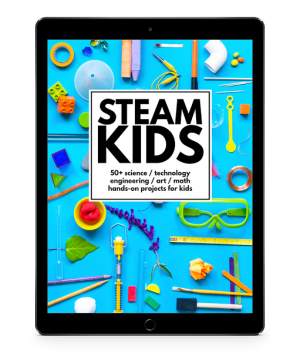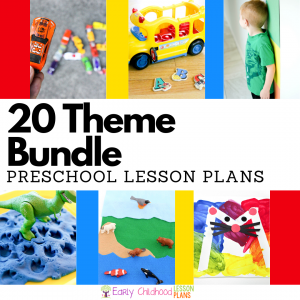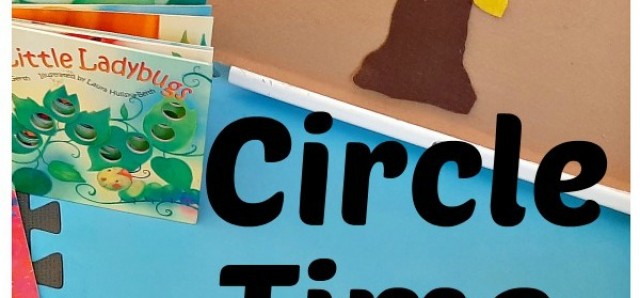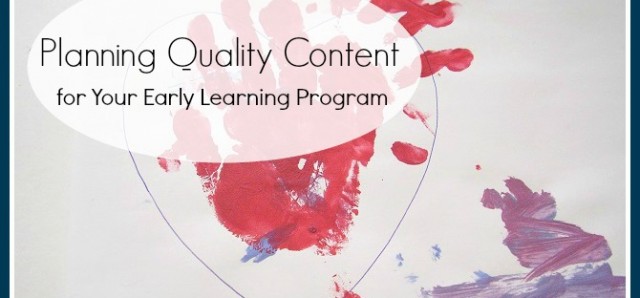Easy Method to Prepare Preschool Programs
Prepare your preschool, kindergarten, or toddler program in minutes with our convenient ABC Method. Compile and sort activities that will be available for scheduling when you need them.
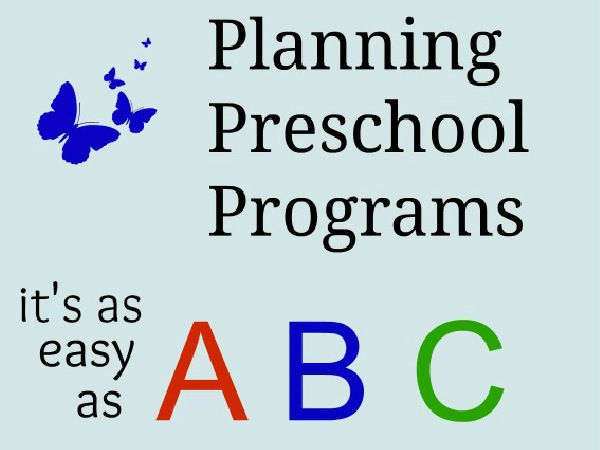
This post contains affiliate links. Privacy and Disclosure
Is planning your preschool program an exciting part of your weekly or monthly routine?
Finding just the right book or activity is a joy, but it can also be time consuming. Any steps you can take to make your job easier are a bonus.
It is my hope that the ABC Method will do the heavy lifting for you, compiling and scheduling daily activities with ease.
A.B.C method for planning preschool programs
As early learning teachers and parents your day is occupied with teaching, supervising, nurturing, and playing!
Finding and planning activities can also require a generous portion of your time.
With the diversity of teachers and students engaged in early education, no two early learning programs will be the same, even with similar activities.
But key components of an early learning program will be included in most early childhood environments. They are reflected in the the letters A.B.C. used to name our planning method.
A = Activity B = Book C = Craft
These general categories support early childhood development as kids play.
Each experience provides early learners with new or familiar experiences, in independent play and in small or large group settings.
NOTE: How schedules for the home or classroom are developed will vary according to teaching styles, early learning environments, time restraints, and ages, interests, and skill levels of the children.
Here are the ABC categories explained in more detail.
Activity
Activities can be gross motor, such as indoor bowling, or fine motor, such as sorting shape cutouts on the felt board.
They can be teacher-led, such as a the teacher or parent reading a book during circle time, or child-led, creating stories with puppets during free play time.
Activities may be introduced one on one or in a small or large group setting.
Book
Include at least one or two titles daily. Even with a scheduled book reading at circle time, other opportunities may occur throughout the day when reading is welcome and appropriate.
While story time generally takes the form of a traditional book, a creative story telling method employing a felt board or role play can be a fun alternative.
- For example, story time can be extended by role-playing The Three Bears after reading the book together.
Craft
Arts and crafts sessions provide opportunities for kids to imagine and create with a wide variety of art supplies and mediums.
Include basic materials like paper and paint, glitter and glue, crayons and markers, as well as ribbon, yarn or stickers for more sensory and fine motor art opportunities.
Provide other mediums such as play dough, kinetic sand, and slime for additional creative play options.
Balance craft 'tutorials', that require specific steps, with process art experiences that promote the process and the not the product. This will provide kids with a variety of learning opportunities.
How to use the A.B.C. Method to plan a program
The ABC method helps you find and schedule hands-on, engaging activities.
Program planning is made easy with just two steps!
Step 1. Compile content.
- Create original content.
- Visit libraries.
- Purchase written material.
- Search online.
Create a storage system that is convenient for you.
Retain information in a digital spreadsheet or Google doc, or as a hard copy in a 3-ring binder.
Keep a small notebook with you to jot down ideas anytime of day, or store on your mobile device. Add these ideas later to your resource file.
Sort content by theme or topic.
Themes or topics provide platforms for organizing and sorting content.
You can start with broad categories such as 'seasons' and 'animals', then become more specific with sub-categories such as 'leaves' and 'dinosaurs'.
You can sort by learning skill such as fine motor or gross motor, math or literacy, sensory or pretend play.
This sample spread sheet shows how you can create thematic units and store content.
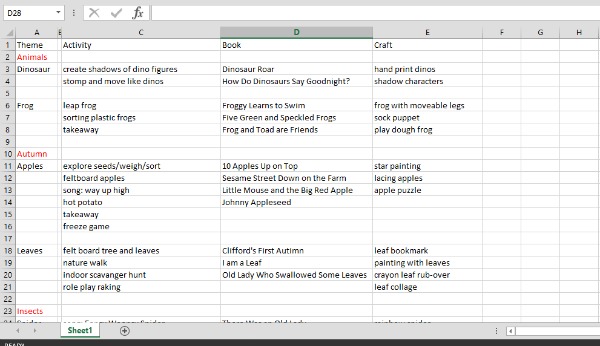
You can add columns to separate entries in the Activity section into gross motor and small group activities, or label each entry with skill category such as fine motor, sensory or math. This will show you at a glance the various learning skills that are being supported through everyday play.
You can make a separate category for special events like field trips, or visitors to your center. The categories you create will depend on your preferences and range of activities offered.
You can also add links or cite sources, include lyrics to songs and instructions for games.
You might like to add a column for your comments as follow up to any activity, to alter or improve it in the future.
Continue adding relevant content to your selected categories as you find or create activities.
Step 2. Plan a week of activities in minutes!
- Specify a theme or topic, or choose a "general" category.
- Select activities from this category in your storage file.
- Add activities to a daily or weekly planner.
Activities can be sorted with this simple template.
This chart can be edited or printed in Canva. If you want to use as a printed chart multiple times, place it under a transparent plastic cover that can be updated with a wipe-off marker.
Following is an example of how apple activities listed in the spread sheet can be inserted into the printable planner using the ABC Method.
Monday
Activity
Song (tune: I Love You, You Love Me)
Way up high, in a tree, Five red apples smiled at me. So I shook that tree as hard as I could, Down came the apples – mmm, mmm good!Book
Craft
Tuesday
Activity
Freeze game
- Place numbered cardboard apple shapes on the floor.
- Play music while kids walk in the spaces between the apples.
- When the music stops, each participant jumps on an apple and calls out the number.
- Alternately, ask "Who's on number 3?"
Book
Little Mouse and the Big Red Apple
Craft
Apple prints: Cut an apple in half through the middle to reveal a star. Dip the star in paint and stamp onto plain paper.
Wednesday
Activity
Take-away game
- Place several apples of different colors on the table. Cover with a cloth.
- Reach under the cloth to remove one apple without participants seeing which one is removed.
- Uncover the remaining apples. Guess which one is missing.
Book
Craft
Apple puzzle: Draw a large apple on cardstock. Color the apple. Cut the apple into several large pieces. Reassemble the pieces to complete the puzzle.
This is just a sample of what you can do with the ABC Method of program planning. The method is designed to be an easy way to jump start the planning process.
Here are links to some of the activities we've used in the spread sheet.
Let the ABC Method help you build content and organize activities so you can look forward to your time with the kids - stacking blocks, planting seeds, and painting pictures.
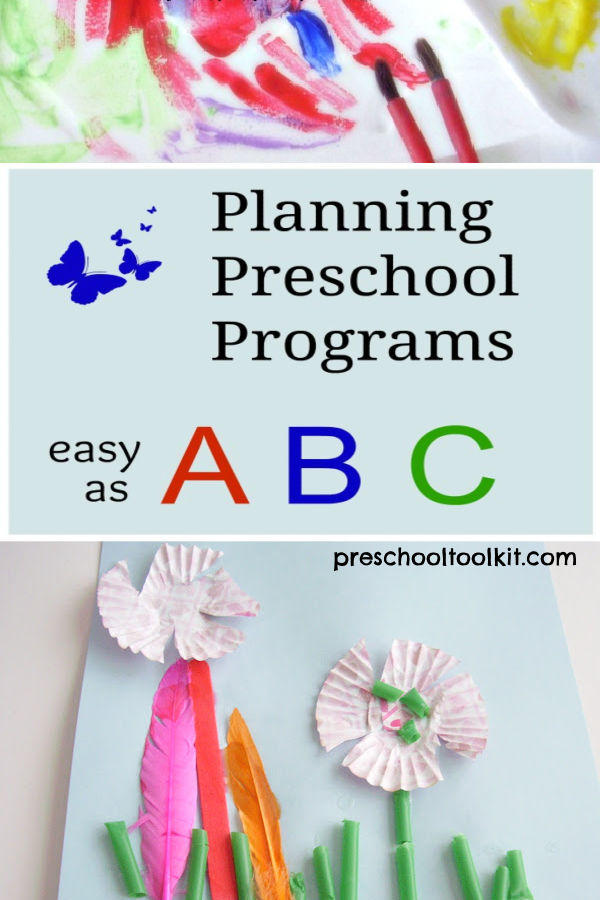
E-books with amazing content! (affiliates)
